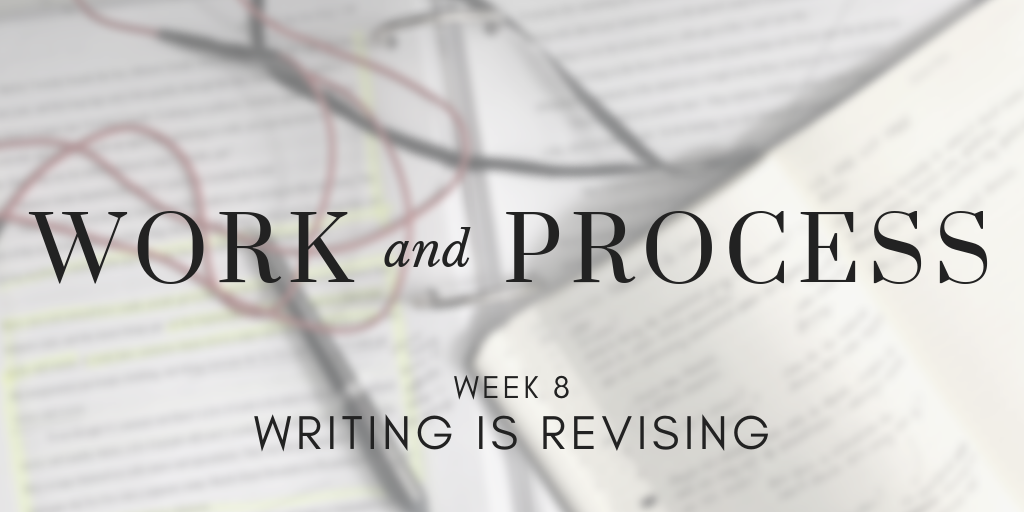|
I make no secret of my unabashed love of revision. It’s my favorite part of the writing process, when I have the basic shape of the project and can finally see where it needs to be chipped away, added to, refined, and polished. I am happiest when I’m dismantling pieces of a book that aren’t working or spending half an hour picking out the exact right metaphor, rhythm, syntax for a single paragraph.
I came to my adoration of revision early in my study of craft, when I was at UC Santa Cruz. In my freshman writing seminar, we were required to produce a 20-page research paper on one of our readings. It was hard. I don’t think any of us had written anything that long and academically rigorous before, so we were all struggling, and about halfway through the quarter, after we’d turned in drafts of our ragged, pitiful attempts, my instructor said something that made me totally rethink the way I approached writing. Revision, she said, is re-envisioning. It seems so simple, after the fact, but at the time, it completely blew my mind. Revision is envisioning your project in a new way. Coming at it from a new angle. Seeing what else it could be. Approaching it from the perspective of knowing that you can tear down whatever you want because you can always make it better, make it whatever it was supposed to be from the beginning, only you couldn’t see it at the time. It felt freeing, knowing that I wasn’t beholden to the words I’d already written, to know that I could delete them and rework them and write new ones, better ones, ones that were truer or more beautiful. What’s so scary about that process is, I think, the feeling like if you have no limits on what you can delete and deconstruct, there’s the very real possibility that you can mess up all the hard work you’ve already done. But I learned something else my freshman year of undergrad, and it was actually in the same quarter, during my Introduction to Creative Writing course. We had a guest speaker (I wish I could remember who, but I’ve since lost my notes from those classes), who came in to talk to us about her books and her process, and she told us that all her second drafts were monstrous. But that’s okay! she said. Let them be monstrous. I remember sitting in that small lecture room, feeling like everything had changed for me… again. Because this was a new freedom, too. The freedom to write something bad. Something ugly. Something flawed and messy and misshapen. To know that I could write long, thick arms of subplots that would unbalance the whole narrative and to know that that was okay because I could always reshape them later. I could always cut them entirely, if I needed to. I could remove huge chunks of story, leaving a project looking skeletal and half-lumbering toward its ending, and in the end, the story would not only survive, but it might just be better for it. (Spoilers for The Reader below.) In The Reader Trilogy, for example, for a very long time, up until the 30th draft or so, Nin was supposed to live. Sefia found her in the Guard’s prison, broke her out, and ran away with her into the Delienean woodland, where Nin, having had enough of Sefia’s family’s hijinks, abandoned her. I still love that plot, because it shows how complicated Nin is. She still loves Sefia, but because of her involvement with Sefia’s family, she’s lost her job, her freedom, her sense of self… and by the time Sefia frees her, she’s just… had enough. She sees Sefia’s okay with Archer, and she makes a choice for self-preservation rather than for love and loyalty. The problem was that the ending of The Reader was so much better if Nin died. If Sefia saw Nin die. If the loss of one more person in her life tipped her over the edge into the person she had to become. So I killed Nin, and I killed this beautiful nuanced subplot, and I didn’t look back. Because it made the story stronger. Revision is re-envisioning. Let it be monstrous. These two concepts not only gave me freedom, they made me brave. I could try things that were risky (and you know how much I love risky), that could damage weeks or months of work… or that could bring everything together in a way both unexpected and inevitable. I could abandon storylines. I could create or destroy characters. I could chop entire chapters if I had to. I could be bold. Because with revision, I could do anything. Next week: MAPS & PACING. A couple weeks ago, I mentioned that I am a structure writer. I have to grasp the structure of a project to really understand it. I think that’s because I am by nature a visual thinker. Which means that when I’m working on a project, I make lots and lots of maps. Since this is a craft blog series, I’d like to share some of them with you, in case they help you in your work and process as well, starting next week with a pacing map I made while I was revising The Reader. Let’s forge ahead next Sunday at tracichee.com and/or post your own responses with the hashtag #workandprocess. In the words of author Chuck Wendig, art harder. <3 Work and Process is a year-long journey of exploring and reflecting on the artistic process, craft, and working in a creative field. Each Sunday, I’ll post some thoughts, wonderings, explanations, and explorations on writing and creativity, and by the end of it, I hope to have 52 musings, examinations, meanderings, discoveries, bits of joy or inquisitiveness or knowledge to share. In each post, I’ll also include a topic for the following week, so if you happen to be inspired to question/wonder at/consider your own work and process, you’re welcome to join me. We’ll be using the #workandprocess hashtag across all social media platforms, and I hope we find each other to learn and connect and transform on our creative wanderings. Comments are closed.
|
ARCHIVES
February 2024
CATEGORIES |


 RSS Feed
RSS Feed